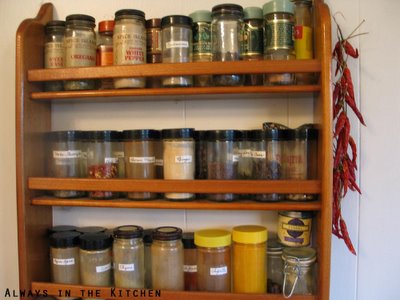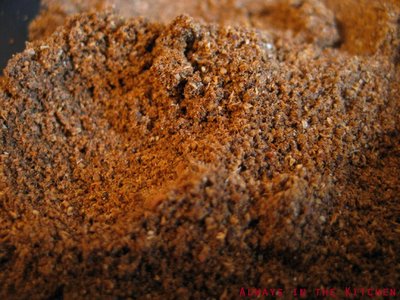I'm a big fan of the spice rack. My particular model was built for me by my father, after listening to me complain about how I could never find one that was big enough to accommodate my
frequent flyers. He built it from reclaimed marine hardwood and presented it to me a few years ago as a Christmas present. I installed it immediately, filled it up promptly, and have been using it ever since. Most of the bottles are old, but the spices, I promise (with the notable exception of the fenugreek seed, which isn't entirely... ah, okay. Except that one. And the Herbs de Provence.) are less than a year old and many of them are considerably less than that.

I use a much greater quantity of herbs and spices than my mother did, although some of that is simply because I cook from my fierier cuisines than she did, by and large. I generally prefer flavours to be full and prominent, although I do still enjoy that whispery sense of
"Can you identify that?" of more subtly flavoured dishes. Using a goodly quantity of herbs makes for going through them more quickly, which makes for fresher stock all the way around. If you are lucky enough to source a shop that does high turnover in good quality spices, that's a good start. If that same store packages their own into little, convenient zip-top baggies and charges only pennies for them, you've got it made. If the mustard seeds are looking kind of faded, or the dill has lost its scent, it usually costs me a pittance to replace them.
One thing that I never really got into, despite a fascination with the spice drawer in my mother's kitchen and a predilection for mixing things together, was spice mixtures. At least, not the commercial ones. The spice mixtures available when I was a kid were usually "Italian Seasoning" (much of which would be salt) and similar convenience packaged things for people who didn't want to measure from more than one bottle, or don't know what sort of herbs were complimentary with each other. I disliked them for the perceived laziness, but also for the lack of control over the quantity of each herb or spice in the blend. Chili powder evaded my distain solely because I was too ignorant to know that it was actually a blend, and not just straight powdered chile.
I still use chili powder, because I found one that I like. I also use a Herbs de Provence mixture, pretty much because we bought it in Provence, which means that it's the oldest thing on my rack. Clearly, I need a trip to France again, and soon! I've unbent on the pre-made mixtures enough to appreciate ones that are well made, but I tend to make my own spice blends. I have a blend for Cajun, one for South West flavours, and perhaps the best one of all, garam masala.
I was disenchanted with commercially purchased garam masala, and intrigued by the recipe that I found in
Seductions of Rice by Alford & Duguid. I promptly scaled the recipe down and gave it a cautious try - to my absolute delight. The house was so thoroughly perfumed with Indian spices that eating anything else for dinner was unthinkable. When I recently made a fresh batch - same thing. Even just thinking about it makes me hungry.
 There are a lot of variations out there on garam masala - some include chiles, or fennel seeds, or other ingredients. The great thing is, you can play with the mixture until you get one you like. I think this one is terrific as is - it's certainly a great starting point.
There are a lot of variations out there on garam masala - some include chiles, or fennel seeds, or other ingredients. The great thing is, you can play with the mixture until you get one you like. I think this one is terrific as is - it's certainly a great starting point.
Garam MasalaAdapted from
Seductions of Rice1/4 cup black peppercorns
1/4 cup whole coriander seed
1/4 cup whole cumin seeds
1 tablespoon whole cloves
1 teaspoon cardamom seeds from the inside of green cardamom pods
1 inch of cinnamon stick, broken
Place a medium skillet over a medium flame and add all of the spices. Dry roast them until fragrant, stirring constantly, and continue to roast for another minute or two after the scent becomes strong. Remove from heat and pour into a bowl to cool for a couple of minutes before grinding.
Place the slightly cooled spices into a spice grinder and grind until a fine, uniform powder is achieved. Allow powder to finish cooling, and then store as you would any ground spice - in a jar or sealed bag, preferably away from light.
This makes just exactly the amount of garam masala for me to fit the whole spices into my grinder all at once. The ground yield is about 3/4 cup.
Have a snack on hand - this will make you hungry.
 Still not able to post new photos (soon, I hope!) but I did manage to find an unposted photo that I had stored elsewhere than my computer. This is a dish that I make quite often - it's quick, it depends on staple ingredients from my pantry, and it is delicious. It's also extraordinarily healthy, being both very low-fat and chock-full of antioxidant black beans.
Still not able to post new photos (soon, I hope!) but I did manage to find an unposted photo that I had stored elsewhere than my computer. This is a dish that I make quite often - it's quick, it depends on staple ingredients from my pantry, and it is delicious. It's also extraordinarily healthy, being both very low-fat and chock-full of antioxidant black beans. 










